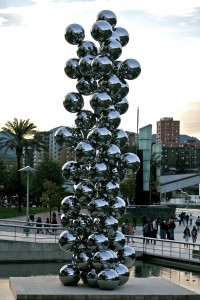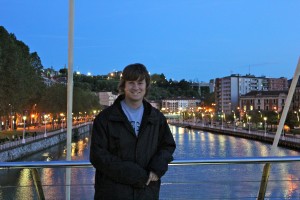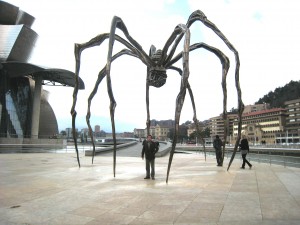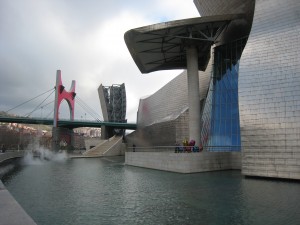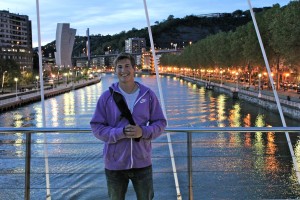 We set off on the bus ride to the beautiful city of Bilbao a few minutes later than expected, thanks to me. A classic mix-up had me at the wrong place, trying to take out money from the ATM to pay for a taxi so I could make the bus in time. Thankfully, the bus driver waited, and we set out as a group of 20 students, safe and sound. On the way, some
We set off on the bus ride to the beautiful city of Bilbao a few minutes later than expected, thanks to me. A classic mix-up had me at the wrong place, trying to take out money from the ATM to pay for a taxi so I could make the bus in time. Thankfully, the bus driver waited, and we set out as a group of 20 students, safe and sound. On the way, some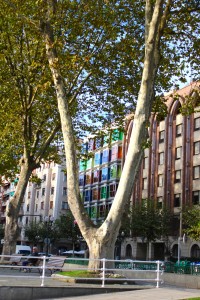 of us watched the back of our eyelids. Others saw the beautiful Basque country roll by the windows, which was the only thing that made the long ride tolerable.
of us watched the back of our eyelids. Others saw the beautiful Basque country roll by the windows, which was the only thing that made the long ride tolerable.
Upon arrival in Bilbao, we settled into our hotel before going to see the famous Guggenheim Museum. The modern art museum seemed to have had a large influence on the local community surrounding it. We saw many mural paintings, and artistic layouts of buildings as well as sculptures along the way as we strolled along the Nervion River.
The Guggenheim Museum has been viewed by millions of people in the last decade. The museum has revolutionized the way viewers perceive and experience the world of art as whole. From floral creations of dogs, giant spider sculptures, colorful metallic tulips, and more. The building alone was a massive piece of art.
The Guggenheim has influenced the artistic city and imprinted its own culture on the local people and buildings that surround it. In a city that was once unrecognized in the world of design and art, while seeking more popularity and “capitalidad”, Bilbao failed to compete with other popular cities that flourished with art museums and attractions. But in 1992, the Basque government decided to add a monument that would unite the city of Bilbao. The $89 million structure would soon symbolize the transformation of an irrelevant Bilbao into an attractive destination.
city of Bilbao. The $89 million structure would soon symbolize the transformation of an irrelevant Bilbao into an attractive destination.
The architecture of Frank Gehry’s historical Guggenheim Museum redefined the meaning of art with its design and detail of the buildings structure. Inside, the museum features countless exhibits on four floors. But before we stepped foot inside, the art on the outside by Jeff Koons caught just as much attention as the building itself.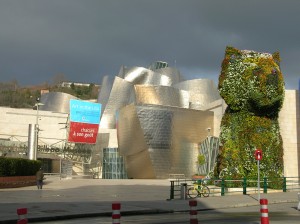
Jeff Koons’ Puppy was first created in 1992 for an exhibit in Germany, and made its way over to Bilbao, Spain in 1997 and is a recognizable piece of artwork outside the entrance into the museum. Students gathered around the Clifford-sized “puppy” for a picture with the beautiful floral terrier. In the summer the flowers have more blooming petals boasting colors that cover the pup from ear to paw.
Jeff Koons’ artwork doesn’t end there however. On the other side of the museum, next to the 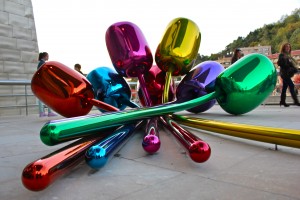 Nervion River is a metallic sculpture colorful of tulips that seem to curve in and out of each other. The bending colors and light in the reflections add another element of artistic appreciation to the viewers. It was one of the more famous sculptures that many of the students had been familiar with even before knowing it was at the Guggenheim.
Nervion River is a metallic sculpture colorful of tulips that seem to curve in and out of each other. The bending colors and light in the reflections add another element of artistic appreciation to the viewers. It was one of the more famous sculptures that many of the students had been familiar with even before knowing it was at the Guggenheim.
No pictures were allowed inside the Museum, yet there was one that had me literally turned around. The mazes designed by Richard Sierra called Snake and Torques Ellipses featured half the bottom floor which had us going in and out of the spiraling circular ribbons of curved steel. I thought I was to the end, when I ended up back where I started, not knowing where I was exactly.
The creation of Richard Sierra weighs around 180 tons; its passages and corridors give you a difficult sense of balance as you move throughout the maze. The walls curve in and out at the same time and alter your overall sense of stability as you walk in circles. Giving most viewers an odd sense of direction, myself included.
As Dylan Gustafson and I started our journey home, we stumbled on our favorite piece of art. Anish Kapoor’s Tall Tree and Eye, which sits on its own island on the river. In the night, the silver balls reflect the lights of the town and the slow dance of the water beneath. The tower of metallic bubbles is a tribute to Kapoor’s obsession of perception, and depth of space.
“I have often said that I have nothing to say as an artist. Having something to say implies that one is struggling with meaning. The role of the artist is in fact we don’t know what to say, and it’s that not knowing that leads to the work.” Anish Kapoor
Walking along the Nervion River that flows through the city and into the Atlantic Ocean, Dylan and I stopped on the bridge to make the memory last with the scene on our backs. The combination of lights, water and the rest of the city made the background glimmer. It was a community that engulfed itself with contemporary art. It was amazing to see how one building could unite the city in the common love for art.
“I thought the architecture of the building was really cool. I don’t know much about architecture but I thought the design and the structure itself was really impressive. I really like the spider sculpture outside the building as well. I thought it looked really cool especially lit up at night.” Said Dylan Gustafson after viewing the Guggenheim Museum.
Ashley Queener agreed with Dylan about the art on the outside of the museum. “I liked all the curves on the outside of the building and how they reflected the light, and I was impressed by the atrium area once inside and its view of the river. The art was pretty interesting to me, but I think I appreciated the museum itself more than the art within.”
The sculptures on the outside were definitely what brought people inside the museum. With all the different interpretations of art, it was hard to wonder how the contemporary artwork on the inside was considered famous. But beauty is in the eye of the beholder, and my eyes were fixed on what the Guggenheim offered for free on the outside of the famous museum.
